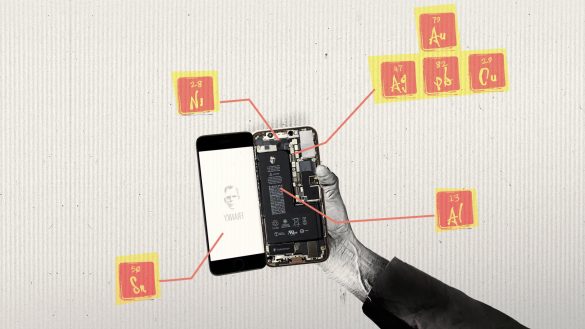Unpacking environmental issues
Ecology is an integral part of our programme schedule. ARTE offers a number of programmes to guide viewers in a discovery of our planet’s treasures, but also to help them understand climate change and think about the practical steps needed to deal with it.
The series Frankenstream – The Devouring Monster has helped to raise awareness of digital pollution. It traces the history of streaming from its beginnings in 1995 to the current dematerialised technology that requires a huge number of servers, cables, networks and data centres in order to function. This in-depth documentary asks questions about the way we consume videos and discusses the tools and settings available to reduce our footprint without compromising viewing quality.
Streaming more responsibly
Video streaming consumes a lot of energy and therefore has a major impact on the environment. Find out here how to adjust your viewing settings to limit your footprint.
Manage your settings
On the arte.tv website or in the ARTE app, you can adjust your settings to reduce your data consumption: go to My settings. Options that have an impact on your energy consumption are indicated by a pictogram (🌿 tree leaf).
You can adjust the video quality to suit your needs. For example, you can choose a lower quality when you are only listening to the sound of the video; this will reduce your data consumption and consequently your carbon footprint. The “automatic” option will choose the best possible quality depending on your bandwidth and screen size.
You can disable the automatic start-up function for programmes and trailers in order to reduce your data consumption.
You can disable automatic launch of the next video in order to reduce your data consumption.
With the ARTE mobile app, you can download programmes to watch wherever you are, even when you have no internet connection. In ⚙️ Settings, you can adjust the quality of downloaded videos and choose to download your favourite programmes over Wi-Fi at home and watch them later when you are out and about. Using 4G consumes around three times as much energy as using the fixed fibre network. (ARCEP, Annual survey “Pour un numérique soutenable”).
Making your screens last longer
The process involved in manufacturing our smartphones, tablets, televisions and computers is a considerable source of pollution, consuming 3/4 of the digital sector’s resources. To make a 2kg laptop, almost 600kg of raw materials need to be extracted (ADEME 2022), but regular releases of new versions of operating systems encourage us to replace our devices at a frenzied pace, even when the ones we have are still in perfect working order. That’s why ARTE is committed to offering you backward compatibility, so that you can watch ARTE even on slightly older equipment.

Smartphones are often replaced, but their components have a major environmental and social impact. One way of limiting the damage is to make them last as long as possible. Photo: Frankenstream, the monster that devours us © Allso
How do I know if my device is backwards compatible?
You can use the ARTE application with operating systems from Android 8 onwards.
On Android TV, you can browse the arte.tv platform with, for example, the NVidia SHIELD released in 2015. The operating system is backwards compatible with Android TV 5.0.
You can use the ARTE application with an iOS operating system from version 16 onwards.
On Apple TV, you can browse the ARTE application with an Apple TV 4 released in 2015 using the Apple tvOS 13 operating system onwards.
The arte.tv platform is backwards compatible with the following browsers and all higher versions: Chrome 72, Edge 80, Firefox 66 and Safari 11.
If you have a Windows computer, you will only need Windows 7, released in 2009, or any other newer operating system. If you have a Mac, you will only need OS X Mavericks, which was released in 2013 and is operational on all devices dating back to 2008. However, these systems are no longer supported by their manufacturers and are therefore not recommended for browsing on arte.tv
Our HbbTV app is compatible with televisions that support the HbbTV 1.1.1 standard, i.e. all Internet-connected televisions released in the last 10 years. However, some features such as UHD or the ability to watch live concerts are only available on newer TVs that support the HbbTV 2.0.2 standard, i.e. TVs released after 2018. This does not prevent users from accessing the full catalogue and using all the other features of the app.
Optimising our browsing system
Streaming generates a huge carbon impact compared with traditional TV broadcasting (satellite, DVB-T, cable or IP-TV). We aim to reduce the negative impact of video viewing on the environment while still offering you a quality experience on our platform, thanks to optimised video encoding and hosting and by monitoring the carbon footprint of the distribution process.
The higher the quality of the video viewed on the platform, the greater its impact on the planet. Our technical teams are looking into solutions to combine image quality with eco-responsibility. The DeepEncode system, for example, can be used to reduce data volumes.
The arte.tv platform uses a content delivery network (CDN). This consists of a set of servers organised in a geographical mesh so as to be as close as possible to users. Thanks to this CDN, we can reduce the distance video files need to travel. As a result, content loads faster and uses less energy. The content delivery network is provided by Akamai, a company that is committed to reducing its carbon footprint.
Our technical and cooling installations have been upgraded, and a carbon impact monitoring system has been introduced using “Smart PDU” measures for energy consumption.
